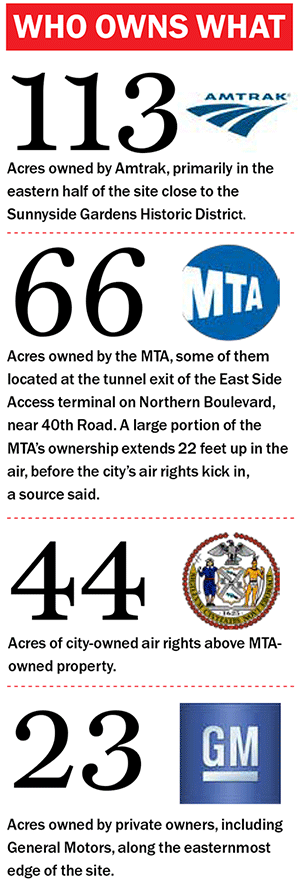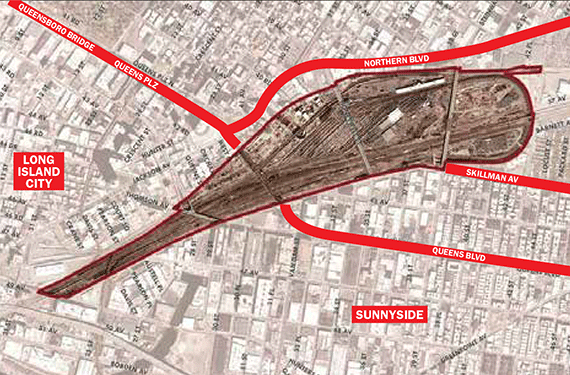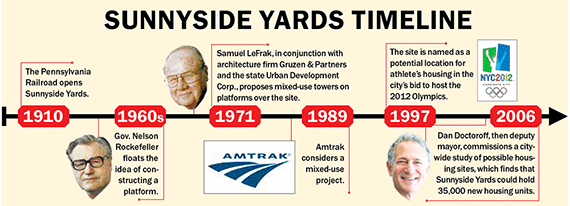When Mayor Bill de Blasio called for the creation of 11,250 affordable housing units at Sunnyside Yards, he was unearthing an idea tossed around for more than 70 years.
The 200-acre, 1.75-mile long rail yard between Long Island City and Sunnyside is large enough to form its own neighborhood, which is in essence what de Blasio wants to do. In his State of the City address, the mayor revived talk of building a platform over the tracks to hold a colossal new housing project, roughly the size of Stuyvesant Town-Peter Cooper Village.
The city Economic Development Corp. will soon choose a firm to conduct a feasibility study aimed at answering questions about the site’s potential. The deadline for EDC’s request for proposals for the study was March 20.
Opposition to de Blasio’s plans cropped up quickly. Gov. Andrew Cuomo backed a proposal from one-time Deputy Mayor (and former Bloomberg LP CEO) Dan Doctoroff — created with SHoP Architects and HR&A Advisors — to construct a 3.1 million-square-foot convention center, 7,000 market-rate units and 7,000 affordable units. The platform and convention center would cost a combined $8 billion.
Critics said EDC should have commissioned its own study for a residential redevelopment before putting out a request for proposals, arguing that not enough preparatory work was done in advance. The early cost estimates for any type of project there are likely far too low, and more comprehensive research should have occurred prior to the mayor’s announcement, sources said.
On the local front, State Sen. Michael Gianaris and City Councilmember Jimmy Van Bramer, who represent Sunnyside, Long Island City and nearby neighborhoods, expressed concerns about the impact on the community’s character and the heightened burden the surge in housing would have on the crowded subway system.
Cost and other deterrents
Developers are skeptical about bidding for a project like this. Sources said if the cost of building a platform were to outweigh the price of air rights, the project could not be justified. However, land values, which are steadily climbing (see related story on page 66), could catch up by the time a deal is struck.
Another issue is the upfront expenses: almost half of the decking and infrastructure costs would arise in the first few years of a likely multi-decade undertaking.
Eric Benaim, CEO of Queens-based residential brokerage Modern Spaces and a Long Island City resident, echoed many neighbors when he said a hospital, school and parkland would benefit the area more than a large-scale housing complex. But developers said community uses would not cover the project’s substantial costs.
 Potential bidders
Potential bidders
The developers most likely to bid on a project of this scope are the ones with experience, a small pool. Forest City Ratner, the Related Companies, Brookfield Property Partners and Silverstein Properties, for example, have built over rail yards.
“The big guys with the deep pockets and the credibility will be the ones making a run at this,” said Decio Baio, a partner at Queens-based commercial brokerage Pinnacle Realty.
Recent examples of similar projects include Hudson Yards, Pacific Park (formerly Atlantic Yards), the High Line and Manhattan West.
Yet this project could potentially dwarf even the largest underway. The roughly 26-acre Hudson Yards is projected to cost $20 billion, while the 22-acre Pacific Park is estimated at $4.9 billion. Both developments are rising above Long Island Rail Road train yards. The five-acre Manhattan West complex, which will sit on a platform over tracks leading into New York Penn Station, has an estimated cost of $4.5 billion.
Sources said Forest City’s close ties to de Blasio — for example, Bruce Ratner’s fundraising for the mayor’s campaign — could give the company an inside track. Forest City raised $73,000 for his 2013 campaign, and is expected to receive $90 million in tax-exempt bonds from the city this year. Silverstein Properties also is well-versed with public-private partnerships, the World Trade Center complex being one of the largest projects of this kind. The developers each declined to comment.

